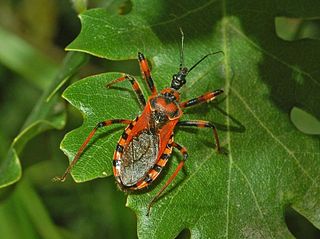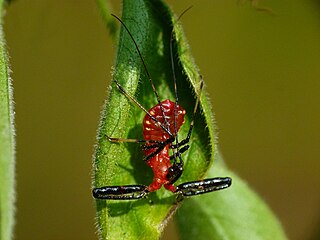Related Research Articles

The Harpactorinae are a large subfamily of the Reduviidae. About 300 genera and 2,000 species worldwide have been described. Some of the species of the genera Zelus, Pselliopus, Sinea, and Apiomerus are of interest as biological pest control agents.

The Apiomerini are a tribe of the Harpactorinae. This tribe is restricted to the New World and consists of 11 genera.

Harpactorini is a tribe of the Harpactorinae. This group is the most diverse of the entire assassin bug family, with 51 genera recognized in the Neotropical Region and 289 genera and 2003 species overall.
Harpactor angulosus is a species of true bug (Harpactorinae). This assassin bug has been documented preying on caterpillars of the genus Hylesia in Viçosa, Minas Gerais State, Brazil. Caterpillars of this genus are an agricultural pest. H. angulosus, like other species of Harpactorini, has potential as a biological pest control agent.
Pahabengkakia piliceps is a species of true bug (harpactorinae) found in Thailand. This species is apparently a specialist predator of the stingless bee Trigona collina. Larval P. piliceps mimic the bees, and eggs are laid in the bees' hives. Nymphs of P. piliceps were found to occupy the nest entrance and kill returning foraging bees. The assassin bug does not seem to predate other Trigona species, even though they are also present in the area.

Repipta is a mostly neotropical genus of assassin bug, family (Reduviidae), in the subfamily Harpactorinae.
Cosmoclopius is a genus of South American assassin bugs, in the subfamily Harpactorinae.
Liangcoris is a monotypic genus of assassin bugs, in the subfamily Harpactorinae.

Euagoras is a genus of assassin bugs, in the subfamily Harpactorinae. Species are found in Asia and Australia.
Euagoras plagiatus is an Asian species of assassin bugs, in the subfamily Harpactorinae. It has been investigated as a potential biocontrol agent for Pterophorus lienigianus Z., which is a pest of eggplant.
Irantha is a small and little-known genus of assassin bug family (Reduviidae), in the subfamily Harpactorinae. Just four species have been described.
Rhynocoris tristis is a species of assassin bug family (Reduviidae), in the subfamily Harpactorinae. R. tristis is a polyphagous predator found in sub-Saharan Africa.

Pselliopus is a common genus of assassin bugs (Reduviidae), in the subfamily Harpactorinae. The genus is restricted to the New World, with 27 species described. Some species, such as Pselliopus barberi, are conspicuous because of their bright coloring and relatively large size. Some species of the genus are of interest as potential biological pest control agents.

Rhynocoris iracundus is an assassin and thread-legged bug belonging to the family Reduviidae, subfamily Harpactorinae. The species was first described by Nikolaus Poda von Neuhaus in 1761.

Rhynocoris rubricus is a species belonging to the family Reduviidae, subfamily Harpactorinae.
Zamolxis is a genus of assassin bugs, in the subfamily Harpactorinae.
The Dicrotelini are a tribe of assassin bugs in the subfamily Harpactorinae. Originally described by Carl Stål, genera and species have been recorded from Asia and Australia.

Rihirbus is a genus of assassin bug from the tropical parts of the Oriental region. They belong to the Harpactorinae and the genus is unique in having the fore tibiae with incurved tips and the apex having a long tooth. They show sexual dimorphism and are polymorphic making their identification to species complicated. Females are larger and wider. R. trochantericus takes about 49 days to develop from egg to adult in southern India.
Astinus is a genus of assassin bug, in the subfamily Harpactorinae.
Tunes is a genus of assassin bug, in the subfamily Harpactorinae, containing a single described species, Tunes saucius.
References
- ↑ Cai, Wanzhi; Tomokuni, Masaaki (2003). "Camptibia obscura gen. and sp. n. (Heteroptera:Reduviidae:Harpactorinae) from China" (PDF). Eur Journal of Entomology.